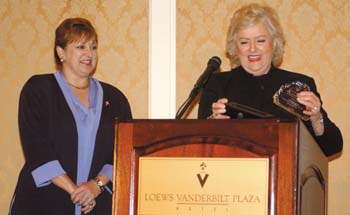
Frances Williams Preston, right, presents the award to Susan Braun at the luncheon this week. (photo by Dana Johnson)
Eicosanoids conference highlights latest cancer research
A symposium on COX-2 and cancer was held on the Vanderbilt campus last week as a special satellite session of the 7th International Conference on Eicosanoids and Other Bioactive Lipids in Cancer, Inflammation and Related Diseases.
The conference, chaired locally by Lawrence J. Marnett, Ph.D., Mary Geddes Stahlman Chair in Cancer Research and associate director for basic science programs at the Vanderbilt-Ingram Cancer Center, was held at Loews Vanderbilt Plaza and attracted some 300 participants from around the world.
“We are pleased to be able to show some of Vanderbilt Medical Center to the meeting participants,” Marnett said, “and also to highlight this very exciting area of research-with so many implications for cancer prevention and potentially for cancer therapy—for the Vanderbilt community.”
Speakers presented the latest findings from animal and human studies on the role that eicosanoids and COX-2 play in the pathways involved in malignancy, and how drugs that block COX-2 might be used to prevent or treat cancer.
Eicosanoids are fatty-acid derivatives that play a key role in mammalian cell signaling, primarily in oxidative pathways. Prostaglandins and related eicosanoids are responsible for tissue responses such as inflammation and wound repair, and are increasingly implicated in many of today’s most common diseases, such as atherosclerosis, Alzheimer disease, rheumatic diseases, and cancer.
COX-2 is an enzyme that plays a key role in the biosynthesis of prostaglandins. Found mainly in inflammatory and immune cells, it is also suspected to play a role in the control of cell growth. Some human tumor cells produce high levels of COX-2.
A special class of non-steroidal anti-inflammatory drugs (NSAIDs) has been developed that act as selective inhibitors of COX-2 activity. Of these drugs, celecoxib—commercially known as Celebrex—was the first to gain FDA approval for use in rheumatoid and osteoarthritis. Celecoxib has now gained limited approval for treating familial adenomatous polyposis (FAP), a pre-cancerous condition of the colon.
Dr. Raymond N. Dubois Jr., Mina Cobb Wallace Chair in Gastroenterology and Cancer Prevention at Vanderbilt and co-chair of the symposium, addressed the effect of celecoxib and other COX-2 inhibitors in FAP and colon cancer in the first presentation of the session.
Modulation of COX-2 expression and activity by NSAIDs decreased tumor number in FAP, he said, and also reduced the development of new blood vessels—supply lines for tumors. COX-2 levels are increased in nearly 85 percent of colon cancers. Based on evidence from pre-clinical studies, several clinical trials are currently underway to test the effectiveness of combination of COX-2 inhibitors with other drugs in preventing or treating human colorectal cancer.
Dr. M. Mark Taketo from the department of Pharmacology at Kyoto University presented corroborating evidence for COX-2 overexpression in FAP in mice, localizing it in the stromal region of the intestinal lumen, and suggested that mutations in the SMAD4 gene contribute significantly to the formation of malignant tumors.
Evidence for chemoprevention of colon cancer by COX-2 and inducible nitric oxide synthase inhibitors was presented by Dr. Bandaru S. Reddy from American Health Foundation. Reddy showed data supporting the synergistic effect achieved by using the drugs in combination to prevent tumor initiation in rats, and to reduce the size of existing tumors.
Dr. Andrew J. Dannenburg, from Cornell University Medical School, discussed implications of COX-2 overexpression in breast cancer. Biochemical evidence that the oncogene HER-2/neu induces overexpression of COX-2 suggests that inhibitors of COX-2 might be therapeutically useful in the subset of women having HER-2/neu positive breast cancer. Phase II clinical trials are currently underway to test blocking COX-2 as a therapeutic strategy.
The only suggestion that COX-2 inhibitors are less than useful in the treatment of cancers came from Dr. Ervin Epstein of the San Francisco General Hospital who discussed the COX-2 connection in skin cancer. A mouse model for squamous cell carcinoma was used to test chemopreventative agents, including retinoids, black and green teas, the NSAID sulindac, and celecoxib. Topical treatment with a retinoid showed significant reduction in tumor number and size, Epstein said, whereas the teas and sulindac showed no real effect. With celecoxib treatment, tumor formation actually appeared to be enhanced.
The final presentation of the day, given by Dr. Robert S. Kerbel of the University of Toronto, addressed using COX-2 inhibitors as adjuvants to traditional chemotherapy. Kerbel suggested that making adjustments to the typical dosing schedule—switching to lower dosages given more frequently—could reduce side effects and avoid the development of multi-drug resistance commonly seen in cancer patients. This “metronomic” strategy of dosing using a combination of traditional drugs and COX-2 inhibitors is showing encouraging results in mice, Kerbel said, allowing continuous therapy for indefinite periods with little negative effect.
At a banquet held the final night of the conference, a BIOMOL Young Investigator Award was presented to each of three recipients in recognition of their outstanding research efforts. Dr. David M. Aronoff, a fellow in the division of Clinical Pharmacology at Vanderbilt, was presented an award in the Structure/Function category for work done in the laboratory of Dr. John A. Oates on the inhibition of prostaglandin H synthase by acetaminophen. An award was given to James Mulhally, Ph.D., from the University of Utah, for his research in cancer, and also to Yoshihide Kanaska, Ph.D., from Harvard Medical School, for research related to inflammation.
The satellite symposium held at Vanderbilt was sponsored by Merck & Co.













